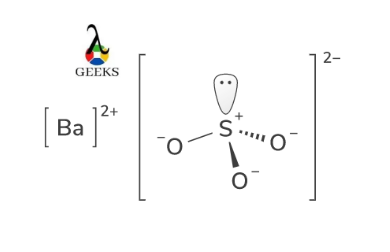H2SO3 (sulfurous acid) is a weak acid. BaCl2 is neither acidic nor basic. It is a salt with no charge. Let us examine the reaction between H2SO3 and BaCl2 in this article.
H2SO3 is a colorless liquid with a strong, burning sulfur odor. H2SO3 is an oxoacid of sulfur. It is a hydrogen sulfite conjugate acid. Barium chloride is an inorganic salt. Barium muriate or barium dichloride is another name for it. It is a white solid that is hygroscopic and soluble in water.
This article discusses how to balance the H2SO3 and BaCl2 reaction, the product of the reaction, the reaction enthalpy, the type of reaction, the buffer solution, and many other aspects of the H2SO3 + BaCl2 reaction.
What is the product of H2SO3 and BaCl2?
When H2SO3 and BaCl2 react, they produce Barium Sulfite (BaSO3) and Hydrogen chloride (HCl) molecules. The following is the reaction equation,
BaCl2 + H2SO3 → BaSO3 + 2HCl
What type of reaction is H2SO3 + BaCl2?
The reaction of H2SO3 + BaCl2 is a double displacement reaction.
How to balance H2SO3 + BaCl2?
The following are the steps for equating the H2SO3 + BaCl2 reaction scheme:
- Using stoichiometry, multiply HCl by two to balance the reactant side
- BaCl2 + H2SO3 → BaSO3 + HCl
- Since the reactant side contains two hydrogen atoms, multiply HCl by two.
- H2SO3 + BaCl2→ BaSO3 + 2HCl
- The reactant and product sides are now equal. On both sides, there are two hydrogens, three oxygens, two chlorines, and one sulfur atom.
- H2SO3 + BaCl2→ BaSO3 + 2HCl
H2SO3 + BaCl2 titration
H2SO3 and BaCl2 cannot be titrated. Because BaCl2 was hardly acidic or basic, it is a salt without charge, and H2SO3 is a weak acid.
H2SO3 + BaCl2 net ionic equation
For the given reaction of H2SO3 and BaCl2, the net ionic equation is,
H2SO3 + BaCl2→ BaSO3 + 2HCl
- The molecular equation should be balanced, and each compound’s phase should be included.
- H2SO3 (aq) + BaCl2 (aq) → BaSO3 (s) + 2HCl (l)
- In the equation, the aqueous salts or chemicals must be converted into ions.
- Weak electrolytes and solids cannot be split apart. Here, H2SO3 is a weak electrolyte, and BaCl2 is solid.
- H2SO3 (aq) + Ba2+ + 2Cl– → BaSO3 (s) + 2H+ + 2Cl–
- Remove the ions that are similar on both sides of the complete ionic equation.
- As a result, the net ionic equation is,
- H2SO3 (aq) ) + Ba2+ → BaSO3 (s) + 2H+

H2SO3 + BaCl2 conjugate pairs
The H2SO3 + BaCl2 reaction produces the following conjugate pairs:
- When H2SO3 donates its H+ ion, the resulting compound is HSO3–, which acts as a conjugate base.
- BaCl2 was neither acidic nor basic; it is a salt with no charge. As a result, it will not produce conjugate pairs.
H2SO3 and BaCl2 intermolecular forces
In the case of H2SO3 and BaCl2,
- Ionic bonds keep Ba2+ and Cl– together in BaCl2. And since ionic bonds are more powerful than dipole interactions, BaCl2 has a higher boiling point.
- The intermolecular force is caused by the strong electrostatic force between protons and sulfite ions in H2SO3, which also has hydrogen bonding.
H2SO3 + BaCl2 reaction enthalpy
The enthalpy data for the H2SO3 + BaCl2 reaction are as follows:
- Reaction enthalpy of H2SO3 is 108.5 kJ
- The enthalpy change of BaCl2.2H2O solution is 8.8 kJ/mol and -20.6 kJ/mol for BaCl2.
Is H2SO3 + BaCl2 a buffer solution?
H2SO3 + BaCl2 is not a buffer solution. Because
- H2SO3 is a weak acid capable of producing two H+ ions.
- Barium chloride is a salt. It has no acidic or basic properties. As a result, it is ineffective as a buffer.
- Buffer solutions are high in a weak acid and its conjugate base (or a weak base and its conjugate acid). Buffers are highly resistant to changes in pH because these components can neutralize added H+ or OH–.
Is H2SO3 + BaCl2 a complete reaction?
H2SO3 + BaCl2 is not a complete reaction. The formation of barium sulfite salt makes the reaction irreversible in nature. However, due to its low acidity, H2SO3 cannot be completely dissociated.
Is H2SO3 + BaCl2 an exothermic or endothermic reaction?
The reaction between H2SO3 and BaCl2 is exothermic in nature because heat is produced during the reaction. In order for the reaction to take place, more energy must be absorbed than is released when salt is formed.
Is H2SO3 + BaCl2 a redox reaction?
The reaction H2SO3 + BaCl2 is not a redox reaction. The oxidation state of elements does not change (H, S, Ba, O, and Cl). Throughout the reaction, the oxidation state has been maintained.
Is H2SO3 + BaCl2 a precipitation reaction?
The reaction H2SO3 + BaCl2 results in the formation of a white precipitate of barium sulfite, which is insoluble in water, and even sulfurous acid.
Is H2SO3 + BaCl2 reversible or irreversible reaction?
The reaction H2SO3 + BaCl2 is irreversible. Because the formation of barium sulfite salt results in a white precipitate, the reaction cannot be reversed.
Is H2SO3 + BaCl2 displacement reaction?
H2SO3 + BaCl2 is a double displacement reaction. When HCl molecules are formed, the barium ion in barium chloride is displaced by the hydrogen ion, resulting in the formation of barium sulfite.
Conclusion
The reaction between H2SO3 + BaCl2 is a double displacement reaction. The anhydrous form of BaCl2 is crystalline, orthorhombic, and monoclinic. It is used in the papermaking industry as well as steel hardening. H2SO3 is used in the production of fertilizers, pigments, dyes, detergents, etc.

Hi … I’m Saina Naushad. I completed my Masters in science with a specialization in Chemistry. I worked with advanced research techniques during my science studies and possessed deep knowledge and expertise in different chemistry topics. I want to help learners better understand advanced Chemistry concepts by sharing my knowledge and skills. please reach out to me on LinkedIn.